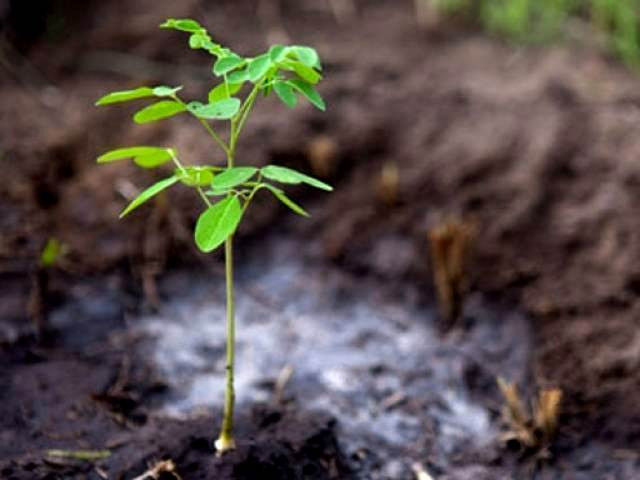Four forestry initiatives Pakistan is taking to fight climate change
K-P’s Billion Tree Tsunami and PM’s Green Pakistan Programme offer a ray of hope for Pakistan’s depleting...

The on-going policy changes and afforestation and reforestation drives offer a ray of hope that Pakistan will be able to regain its lost forest cover. PHOTO: AFP
According to some estimates, the rate of deforestation is estimated to be 27,000 hectares per year at the national level and mainly occurs in private and community-owned natural forests. The reasons are increase in population, demand for firewood, grazing pressure, land conversion for agriculture purposes and illegal logging. A serious environmental issue, deforestation leads to soil erosion, land degradation, loss of biodiversity and worst of all, increase in the impacts of extreme weather events.
The forests are undoubtedly under pressure from various threats but the on-going policy changes and afforestation and reforestation drives offer a ray of hope that Pakistan will be able to regain its lost forest cover, build resilience to climate change, create green jobs and foster sustainable development.
Green policies
Pakistan is set to approve its first ever National Forest Policy which aims to protect and promote the wise use of national forests, protected areas, natural habitats and watersheds. These ecological zones have immense significance and their restoration can improve livelihoods and human welfare.
The National Forest Policy has recently been approved by the Council of Common Interests and experts believe that once enacted into law, the policy will help establish a national forest monitoring mechanism, halt deforestation and assess the amount of carbon stored in trees.
Initiatives to protect forests
REDD+
In the absence of any mechanism by the government to offer incentives to owners of forests, there comes an opportunity in the form the REDD+ initiative. The basic concept of this United Nations initiative is that governments, companies and forest owners in the global South should be rewarded for keeping their forests alive and healthy instead of cutting them down.
As deforestation and forest degradation account for 20% of annual global greenhouse gas emissions worldwide, the United Nations Framework Convention on Climate Change recognises any forestry initiative that reduces emissions to be eligible for incentives. The REDD+ is implemented in three phases - readiness, piloting and results-based payments. The third phase is set to begin in 2020, leading to result-based payments to forest communities for their efforts in protecting trees.
Pakistan, under the able guidance of inspector general of forests, has successfully won a grant of US$3.8 million from the Forest Carbon Partnership Facility which would build the capacity of federal and provincial forest departments to meet the criteria set by REDD+. Eventually, we will be able to receive money from developed countries for forest protection through the REDD+ mechanism.
Inspector General of Forests at the Ministry of Climate Change Syed Mahmood Nasir says the federal government is currently working to submit a proposal for REDD+ incentives under the Green Climate Fund.
Green Pakistan Programme
To address the issue of deforestation and forest degradation, Prime Minister Nawaz Sharif announced the Green Pakistan Programme worth Rs3.7 billion on February 9 which aims to plant 100 million indigenous tree species to conserve and promote flora all across the country.
Nasir says the remaining forests are under pressure and biodiversity is at risk as domestic energy needs are largely met from forest wood.
“Through Green Pakistan Programme, 100 million trees will be planted which will not only help improve the forest cover but also contribute to meeting the domestic demand for wood sustainably. Furthermore, the ministry is implementing the Sustainable Forest Management and Sustainable Land Management projects to contribute to the cause,” he shares.
South Punjab Forest Company
The government of Punjab, in order to reduce dependence on natural forests for fuel wood and other purposes, has established South Punjab Forest Company - a subsidiary of the Forestry, Wildlife and Fisheries Department. The aim is to promote sustainable forestry investments over 134,995 acres across six districts of South Punjab - Bahawalpur, Dera Ghazi Khan, Rajanpur, Rahim Yar Khan, Muzaffargarh and Bahawalnagar. The company will lease forest land for 15 years, which can be further extended to another 15 years, to raise plantations that can fulfil the needs of the wood-based industry and as a result, create green jobs, reduce import bills and halt logging pressure on the natural forests in Punjab.
Commenting on the nexus between forests and energy, South Punjab Forest Company CEO Tahir Rasheed says about 50% of global wood production, i.e. 1.86 billion cubic meters, is used as energy for cooking, heating, and electricity generation by around 2.4 billion people.
“This International Day of Forests highlights the importance of forests and the services they provide. Forests can help us achieve Goal 15 of the Sustainable Development Goals which aims to conserve and promote sustainable use of terrestrial ecosystems, sustainable forest management, halt desertification and reducing biodiversity loss,” he hopes.
Billion Tree Tsunami project
The Khyber-Pakhtunkhwa government initiated a unique forestry programme called the Billion Trees Tsunami Afforestation Project to increase forest cover in the province. The project will reach its target of one billion trees in K-P by this year’s end – earlier than the initial deadline of 2018. It has so far planted 750 million trees across the province and created job opportunities for 500,000 people. The initiative has also led to unprecedented natural regeneration in K-P’s forests up to 2300 plants/ha.
The project has been recognised as the fourth biggest initiative of afforestation/reforestation in the world and is the only provincial initiative to be recognised under the Bonn Challenge - a voluntary initiative to restore 150 million hectares of the world’s deforested and degraded land by 2020 and 350 million hectares by 2030.
According to Malik Amin Aslam Khan, Regional Councillor for Asia at International Union for Conservation of Nature (IUCN) and chair of K-P’s Green Growth Initiative, Billion Trees Tsunami project addresses the critical issue of low forest cover and deforestation in Pakistan.
“Pakistan has had a very low forest cover and its remaining forests have traditionally been a rapidly depleting resource. However, the Billion Trees Tsunami Afforestation Project has endeavoured to reverse both these trends as 0.15 million hectares of new forest plantations are on ground now – this is equivalent to 2% of K-P’s total area. This will not only help in adapting to extreme climate changes but also contribute to the global efforts for climate mitigation through enhanced carbon storage,” he explains.
Syed Muhammad Abubakar is an international award-winning environmental writer with an interest in climate change, deforestation, food security and sustainable development. He tweets @SyedMAbubakar and can be reached at s.m.abubakar@hotmail.com



















COMMENTS
Comments are moderated and generally will be posted if they are on-topic and not abusive.
For more information, please see our Comments FAQ